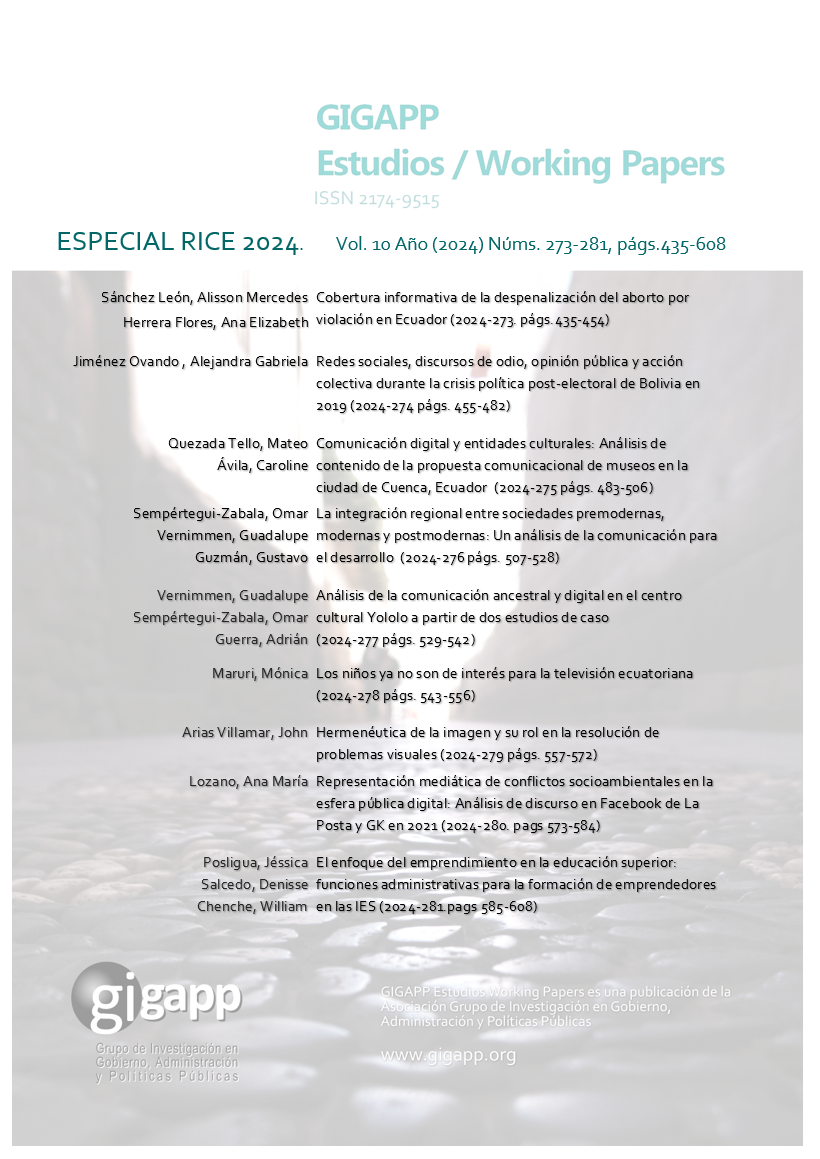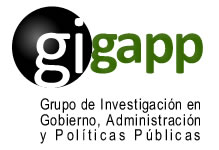Redes sociales, discursos de odio, opinión pública y acción colectiva durante la crisis política post-electoral de Bolivia en 2019
Resumen
Tras los comicios electorales del 20 de octubre de 2019 en Bolivia se desató una crisis política que dejó como consecuencia alrededor de 35 muertos, 833 heridos y 1504 arrestados; además de un retroceso democrático consumado en un Golpe de Estado. Sin embargo, la crisis política post electoral de octubre de 2019 deviene de un contexto de conflicto político que encuentra su génesis en el referéndum constitucional del año 2016 que buscaba la habilitación a la repostulación de Evo Morales.En medio de este contexto, en las redes sociales digitales se empezaron a percibir discursos de odio y racismo alrededor del entonces presidente de Bolivia, Evo Morales y quienes sean afines a su partido de gobierno; con distintos tipos de recursos tanto narrativos, gráficos y audiovisuales. En este sentido, el presente trabajo mediante una estrategia metodológica cualitativa, describe el papel de las redes sociales, en el golpe por goteo desde un proceso sistemático que deviene de 2016 en dos dimensiones: la primera como espacio de disputa política para deslegitimar la figura de Evo Morales y la segunda, como estructura de movilización de la acción colectiva de los jóvenes de la denominada “Generación Pitita” que legitimaron el Golpe de Estado en Bolivia. Es decir, se encontró que las redes sociales desempeñaron un papel significativo en la amplificación de discursos polarizados y en la movilización de grupos con intereses políticos diversos. Estos discursos de odio exacerbaron las tensiones y contribuyeron a la escalada de la violencia. En este sentido, los principales hallazgos versan sobre la incidencia de lo privado (familiar) en cuanto a las movilizaciones de los jóvenes de la “Generación Pitita”, al igual que el desconocimiento y confusión respecto a sus universos discursivos, la fuerte incidencia de los discursos de odio sobre todo hacia Evo Morales y sus seguidores, entre otros.
Descargas
Citas
Arendt, Hannah. 1958. La condición humana. Barcelona: Paidós.
Barthes, Roland. 1957. El mito hoy en Mitologías. Buenos Aires: Siglo XXI
Barrera, Augusto.2001. Acción Colectiva y crisis política. EI movimiento indígena ecuatoriano en la década de los noventa. Quito: Ediciones Abya Yala.
Botero, Luis. 2011. Lo público y lo privado en la perspectiva de la comunicación. Colombia: Univer-sidad de Medellín.
Bourdieu, Pierre.1980. La opinión pública no existe. En Cuestiones de Sociología, traducido por Enrique Martín Criado, 220-232 España: Istmo.
Bourdieu, Pierre. 1990. ¿Cómo se forma la opinión pública?. En Le Monde Diplomatique, 15. Edi-ción Nro 151, traducido por Teresa Garufi. Edición PDF.
Breno Bringel.2018. Crisis política y polarización en Brasil: de las protestas de 2013 al golpe de 2016. Madrid: CLACSO.
Brockman Robert. 2020. 21 días de resistencia. Libros de Bolivia: La Paz.
Castells Manuel, M. 2009. Comunicación y poder. Madrid: Alianza Editorial.
Champagne, Patrick. 2002. Hacer la opinión. La Paz: Plural.
Champagne, Patrick. 2005. Hacer hablar a la gente. El uso social de las encuestas de opinión pública. En el misterio del ministerio. Barcelona: Gedisa.
Crespi, Irving. 2000. El proceso de la opinión pública. Cómo habla la gente. Barcelona: Ariel Comu-nicación.
Celaya, Javier. 2008. La Empresa en la WEB 2.0. España: Editorial Grupo Planeta.
Defensoría Del Pueblo del Estado Plurinacional de Bolivia. 2020. Situación de los Derechos Huma-nos en Bolivia después de las elecciones del 20 de octubre de 2019. Bolivia: Defensoría del Pueblo. https://tinyurl.com/s6umpdd6
De Ugarte, David. 2007. El poder de las redes. Barcelona: El Cobre.
Giordano, Verónica. 2014. ¿Qué hay de nuevo en las nuevas derechas?. Revista Nueva Sociedad No 254. https://nuso.org/articulo/que-hay-de-nuevo-en-las-nuevas-derechas
González, Jorge. 2008. Digitalizados por decreto: Cibercultur@ o inclusión forzada en América La-tina. Estudios sobre las Culturas Contemporáneas.
Habermas, Jürgen.1981. Historia y crítica de la opinión pública. Barcelona: Editorial Gustavo Gili.
Hernández Sampieri, Roberto, Carlos Fernández Collado y Pilar Baptista.1991. Metodología de la investigación. México: McGraw Hill.
Javaloy Manzón, Federico, Esteve Espelt y Alvaro Rodríguez. 2007. Comportamiento colectivo y movimientos sociales en la era global. En Morales, J., Gaviria, E., Moya, M. & Cuadrado, I. (Coords). Psicología social, 3ra edición. España: Mc Graw Hill.
Katz, Elihu y Paul Lazarsfeld.1979. La influencia personal. El individuo en el proceso de comunica-ción de masas. Barcelona: Hispano Europea.
Lago, Silvia.2015. Movimientos sociales y acción colectiva en la sociedad red. Chasqui, Revista La-tinoamericana de Comunicación 128. Ciespal: Ecuador
Lazarsfeld, Paul.1957. Public Opinion and the Classical Tradition en The Public Opinion Quarterly. Estados Unidos: Oxford University Press. Edición PDF.
McAdam, D., Tarrow, S. y Tilly, Ch. 2005. Dinámica de la contienda política. Barcelona: Hacer Edito-rial.
McAdam, John, John McCarthy y Mayer N. Zald.1999. Movimientos sociales: perspectivas compa-radas oportunidades políticas, estructuras de movilización y marcos interpretativos cultura-les. Madrid: Istmo.
Melucci, Alberto.2010. Acción colectiva, vida cotidiana y democracia. México: Colegio de México.
Noelle-Neumann, Elisabeth.1995. El estereotipo como vehículo de difusión de la opinión pública: Walter Lippmann en La espiral del silencio: opinión pública nuestra piel social. Buenos Aires: Paidós.
Norman Fairclough. 2003. Discourses in Analysing Discourse. Textual analysis for social research. Reino Unido: Routledge
Pizzorno, Alessandro.1994. Identidad e interés. Madrid: Editorial Pablo Iglesias.
Rovira, Guiomar. 2012. Movimientos sociales y comunicación: la red como paradigma. México: Universidad Autónoma Metropolitana.
Tilly, Charles. 1998. Conflicto político y cambio social en Los movimientos sociales. Transforma-ciones políticas y cambio cultura de Ibarra, P y Benjamín Tejerina. Madrid: Trotta,
Tilly, Charles.2007. Contienda política y democracia en Europa. Barcelona: Editorial Hacer.
Torres, S. 2013. Internet como motor del cambio político: Ciberoptimistas y ciberpesistas en Revis-ta del Instituto Español de Estudios Estratégicos. España: Instituto Español de Estudios Es-tratégicos. Edición PDF.
Van Dijk, Teun. 2005. Política, ideología y discurso. En Quórum Académico. Venezuela: Universidad del Zulia
Van Dijk, Teun A. 2008. El discurso como interacción en la sociedad en Teun A. Van Dijk, compila-dor, El discurso como interacción social. Estudios sobre el discurso II. Una introducción multidisciplinaria. Barcelona: Gedisa.
Van Dijk, Teun A. 2009. Estructuras de discurso y estructuras de poder en Discurso y poder. Barce-lona: Gedisa.
Velasquez,Víctor. 2020. Una nueva estrategia de golpe de estado en Bolivia “golpe blando en Boli-via 2019”. La Paz: UMSA
Derechos de autor 2024 Alejandra Gabriela Jiménez Ovando (Autor/a)

Esta obra está bajo licencia internacional Creative Commons Reconocimiento-NoComercial-CompartirIgual 4.0.
Aquellos autores/as que tengan publicaciones con esta revista, aceptan los términos siguientes:
a. Los autores/as conservarán sus derechos de autor y garantizarán a la revista el derecho de primera publicación de su obra, el cuál estará simultáneamente sujeto a la Licencia de reconocimiento de Creative Commons Attribution-NonCommercial-ShareAlike 4.0 International (CC BY-NC-SA 4.0) que permite a terceros compartir la obra siempre que se indique su autor y su primera publicación esta revista.
Con esta licencia de acceso abierto, los lectores (usuarios) pueden:
- Compartir — copiar y redistribuir el material en cualquier medio o formato
- Adaptar — remezclar, transformar y construir a partir del material
Bajo los siguientes términos:
-
Atribución — usarios deberán dar crédito de manera adecuada, brindar un enlace a la licencia, e indicar si se han realizado cambios. Puede hacerlo en cualquier forma razonable, pero no de forma tal que sugiera que usted o su uso tienen el apoyo de la licenciante.
-
NoComercial — usuarios no puede hacer uso del material con propósitos comerciales.
-
CompartirIgual — Si remezcla, transforma o crea a partir del material, usuarios deben distribuir su contribución bajo la misma licencia del original.
-
Sin restricciones adicionales: los usuarios no pueden aplicar términos legales o medidas tecnológicas que restrinjan legalmente a otros de hacer cualquier cosa que permita la licencia.
b. Los autores/as podrán adoptar otros acuerdos de licencia no exclusiva de distribución de la versión de la obra publicada (p. ej.: depositarla en un archivo telemático institucional o publicarla en un volumen monográfico) siempre que se indique la publicación inicial en esta revista
c. Se permite y recomienda a los autores/as difundir su obra a través de Internet (p. ej.: en archivos telemáticos institucionales o en su página web) antes y durante el proceso de envío, lo cual puede producir intercambios interesantes y aumentar las citas de la obra publicada. (Véase El efecto del acceso abierto).



